Now that the trout fly fishing season is over, it’s time to take a look at my top ten grayling flies for October.
These flies provide you with a great place to start if you’re new to grayling fly fishing. Additionally, they will benefit the more experienced fly anglers.
On UK rivers, fly hatches are beginning to diminish in October, but on mild days, you might spot any of the following flies:
Upwing Flies
- Large Dark Olive
- Autumn Dun
- Iron Blue Dun
- Pale Watery
So, it’s time to reveal my…
top 10 grayling flies for October fishing on the Welsh Dee
i.e. fly patterns that I have found consistently catch grayling.
My 3 best grayling flies for October:
Based on the variety of natural flies, you would think an extensive selection of fly patterns would be required to catch grayling consistently.
However, after analyzing my detailed fishing log, surprisingly, over the last 5 years 80% of the grayling I’ve caught in October were on these wet flies:
- 35% on March Brown spider patterns
- 30% on Black Hopper
- 15% on Claret midge
Therefore, I recommend starting with this three-fly cast on a 3lb copolymer (point: #14 March Brown spider; middle dropper: #14 black hopper; top dropper: #16 claret midge).
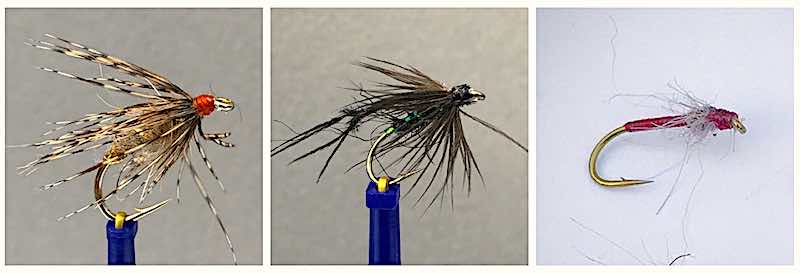
If you only want to fish one fly then it would have to be one of the following March Brown spider patterns, since often…
“it WINS hands-down on the Welsh Dee”
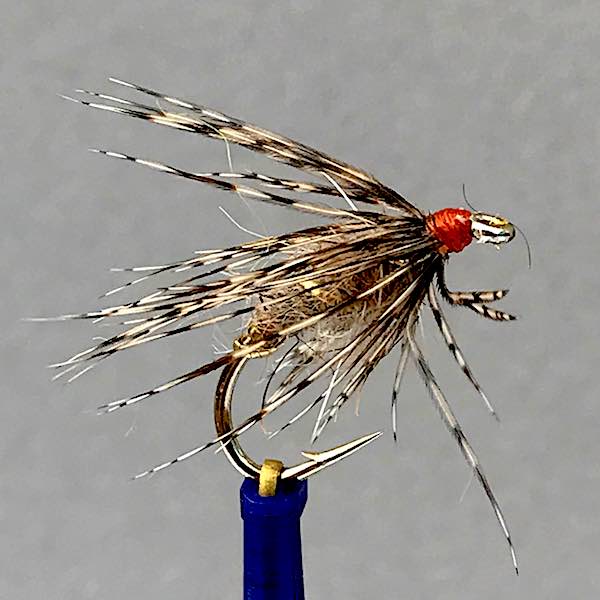
March Brown Spider
- Hook: Kamasan B170 #14
- Thread: 8/0 rusty orange
- Optional underbody lead wire
- Body: Hare’s Ear
- Rib: Gold oval tinsel
- Hackle: Brown partridge neck
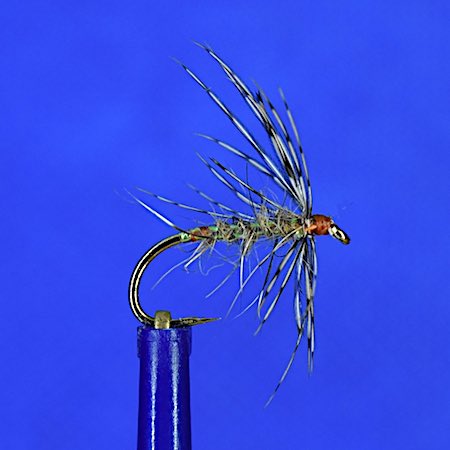
Pearl-ribbed March Brown Spider
- Hook: Kamasan B170 #14
- Thread: 8/0 Rusty orange
- Body: Hare’s Ear dubbing
- Rib: Pearl Mylar #14 (1/32)
- Hackle: Brown partridge neck
The other two wet flies that feature highly in my catch returns are the trusty black hopper and a red spider.

Black Hopper
- Hook: Kamasan B170 #14
- Thread: Black UNI-Thread 8/0
- Body: Black Seals fur substitute
- Rib: Pearl Mylar #14 (1/32)
- Legs: Black pheasant tail
- Hackle: Black Hen
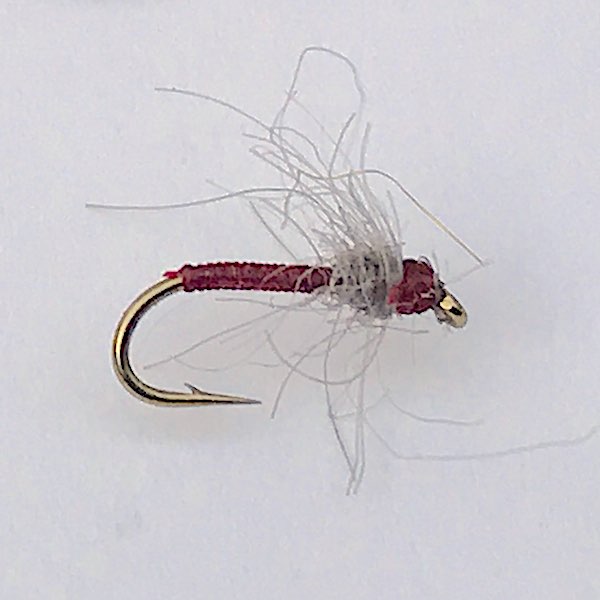
Claret midge
- Hook: Kamasan B170 (#16 & 18)
- Body: Claret UNI-Thread 8/0
- Hackle: Grey Vends dubbing
Where best to fish the grayling wet flies?
When the Welsh Dee is close to its summer level (<0.5m Manley Hall gauge), I focus my fishing in the following areas because they tend to yield the best results:
- the fast water leading into pools;
- the glide leading into the tail of the pool;
- behind weed beds, large rocks, ledges, and snags.
For more on how I fish wet fly check out the page dedicated to wet fly fishing.

Now let’s consider what to do if the above approaches fail to catch grayling.
I do catch grayling during October on dry flies and Czech nymphs. So, let’s take a look at these…
Best grayling dry flies for October
When grayling are preoccupied with taking dry flies, the best approach is to try and match the hatch. If you are unable to do this, grayling will likely be taking one of the following:
- olives,
- Iron Blue dun
- autumn dun,
Hatches of the upwing flies often occur in riffles and near the heads of pools where the flow is faster. Dry fly fishing in these areas with a small fly will often tempt grayling.
If I was limited to one dry fly it would be an olive CDC emerger. However, it is worth tying alternatives with various body colours (black, grey, dark olive, brown, claret, etc.)

CDC Olive emerger
- Hook: Kamasan B100 #16 & 18
- Thread: Olive UNI-Thread 8/0
- Rib: Fine gold wire
- Thorax: Hare’s ear dubbing
- Wing: 3-4 CDC feathers
Other examples of successful dry flies for October include:
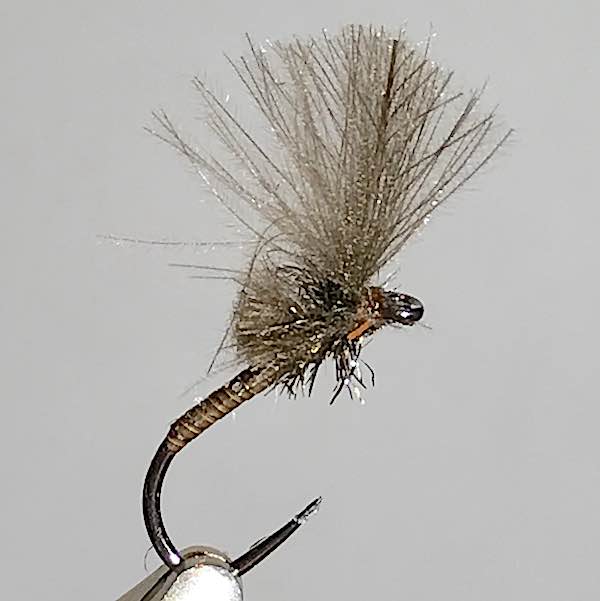
Olive Quill Emerger
- Hook: HENDS BL345 #16 & 18
- Thread: Tan UNI-Thread 8/0
- Body: Peacock quill
- Thorac. Peacock Herl
- Wing: 3 CDC feathers

Crumpled Iron Blue emerger
- Hook: Kamasan B170 #16 & 18
- Thread: Grey UNI-Thread 8/0
- Tail: Grey Anton yarn
- Body: Mole fur
- Indicator: Orange Anton
- Hackle: Crumpled Iron Blue cock
When grayling are seen sipping midges in the slacker sections of the pools, I find that either a Griffith Gnat or a small F-fly will often work very well:
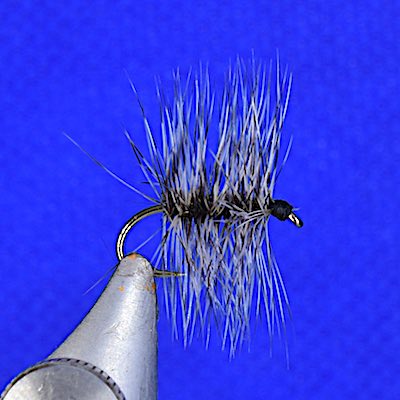
Griffith Gnat
- Hook: Kamasan B170 #18
- Thread: Black UNI 8/0
- Body: Peacock herl
- Hackle: palmered Grizzle cock
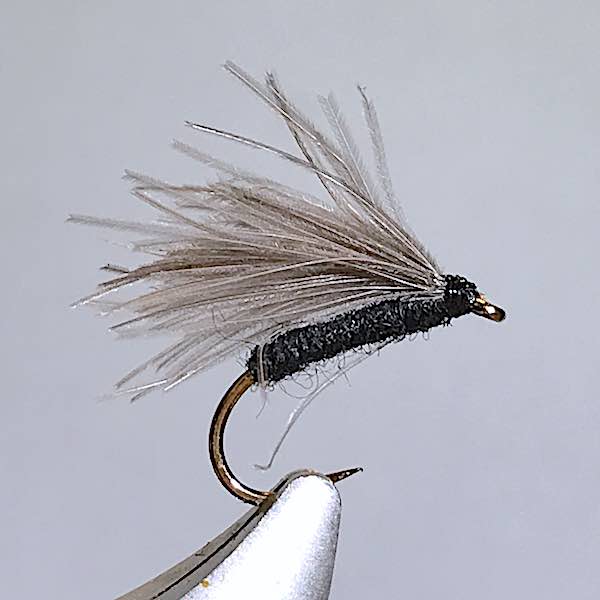
F-fly in various colours
- Hook: Kamasan B170 #16 & 18
- Thread: Black UNI 8/0
- Body: Fine black dubbing
- Wing: 3 CDC feathers
I find it difficult to spot the small dry fly in fast water and when this happens I prefer to switch to the double dry fly fishing method:
- sight fly – size 12, elk hair caddis (cream tag), and
- small trailing fly 18” behind the sight fly (e.g. F- fly, Griffith Gnat, etc.)

Elk hair caddis
- Hook: Kamasan B170 #12
- Thread: Rusty orange UNI 8/0
- Body: Hare’s Ear dubbing
- Rib: Fine gold wire
- Wing: Elk hair – tied upright
Czech nymph selection for October grayling:
I’m usually salmon fishing until the 17th of October if the Welsh Dee is above its summer level (0.5m Manley Hall gauge). Therefore, most of my October grayling fishing is during dry spells, when I find wet fly & dry fly fishing often yield the best results.
Czech / Euro nymphing is not everyone’s cup of tea but it’s the best way to catch grayling feeding on the riverbed. My preferred nymphs for October include…

Pheasant tail nymph (orange tag)
- Hook: Hends BL154 (#14 & 12)
- Bead: 2.5mm tungsten (silver & gold)
- Thread: Brown UNI-Thread 8/0
- Tail: 3 pheasant tail fibre
- Body: pheasant tail fibres
- Rib: Fine copper wire
- Thorax: Olive dubbing
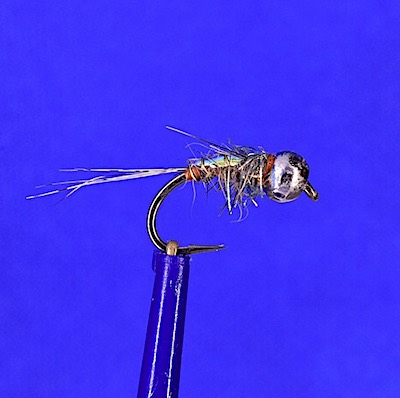
Hare Ear shell-back nymph
- Hook: Kamasan B100 #14 & 16
- Bead: 2 – 3mm tungsten (pink, gold)
- Thread: 8/0 rusty orange
- Body: Hare Ear
- Back: Mylar tinsel
- Rib: gold wire
The above advice comes from my fishing log covering flies that have reliably caught grayling, thus a great starting point for a newcomer to the Welsh Dee. In addition, it may help more seasoned anglers to modify their approach and improve their catch results.
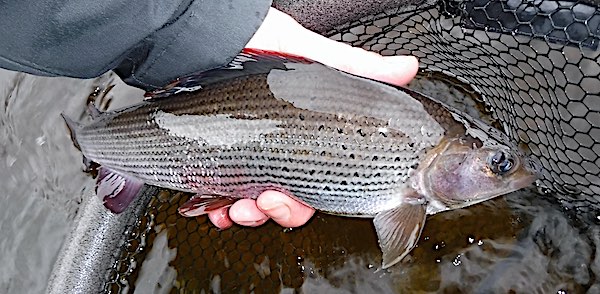
For more information on fly fishing for grayling during autumn, check out the following post:
- Grayling fly fishing in Autumn with a focus on the beautiful Welsh Dee
- Fishing in October yields some wonderful grayling
- October fishing report from the banks of the amazing Welsh Dee
If you are interested in grayling fishing on the Welsh Dee, there is some excellent Day Ticket water.
I hope you found my top 10 grayling flies for October post interesting, and it would be great to hear what your best October grayling flies are.

thanks Andrew ,seems that the march brown spider and the black hopper are the most effective flies, on the Dee whatever the time of the year .I have tied a few of each ,and still hoping to get to fish at Llangollen this October if the dreaded covid doesn’t force another lockdown
Hi Alan,
Over the years those two flies have accounted for lots of trout and grayling, and I don’t go fishing without a few in my fly box. Let me know how you get on fishing them if you manage to go fishing in October.
Cheers, Andrew
Great information . Used your advice many times and have caught lots of times
Cheers
Hi Tim,
It’s great to hear that the posts are helping you catch fish.
Cheers, Andrew.
Hi Andrew, I find your blog very interesting has you go through the seasons.
just whish i had the time to visit the Dee. Your top Ten Grayling flies are not a complete mystery to me. Ive booked a day on the upper Wye next week, will certainly tie a few of your top ten and give them a go. Ill let you know how I get on.
Hi Tony,
Pleased to hear that the article was interesting and useful.
It would be great to know how the flies perform on the upper Wye. I hope you have a good trip.
Cheers, Andrew
The olive quill emerger is one of my favourite flies, had a few sea trout on mine last back end. Thanks Andrew for another informative article.
Hi Peter,
Great to hear that it is your favourite pattern. I’ve not had any sea trout on it but have caught a few fishing an Elk Hair caddis pattern.
Cheers, Andrew
Hi Andrew, thanks for the tips, I don’t think I have any of those patterns yet, some shopping to do ! I’ve been fishing the river near Halton, the Manley gauge has been around 0.47m but after recent rain its now 0.87m and rising, what would you suggest in these conditions?
Hi Paul,
I haven’t fished the river at Halton when it’s high but would probably use the flies I fish at Llangollen in high water. Check out this post https://hawker-overend.com/best-grayling-flies-for-december-fly-fishing/ which will give you some ideas.
I hope this helps, Andrew
Hi Andrew, do you fish heavy bugs in the winter. My local rivers respond best to “nymphs” tied with a little pink in them, usually with a tungsten bead at the head. Brilliant article as always, I particularly like the March Brown Spider, this would work well on the Usk at this time of year. If fishing a team of flies their position on the cast is important as well for me.
Hi Alan,
In winter I normally use a heavy point fly to make sure the small droppers are fishing close to the riverbed, especially when the fish are not rising.
Great to hear you enjoyed the article, Tight lines, Andrew.
I’m finding the tips and fly patterns interesting reading. I am hoping to join a club with access to rivers and ive tied a lot of these patterns for trying some grayling fishing this winter. I have very little experience of river fishing so i am using these blogs as research
Hi Martin,
It would be great to know how you get on when you start grayling fishing on rivers.
Good luck, Andrew
I really like the design of the Iron Blue with the orange Antron “indicator,” which the trout must see as something – a wing? a nymphal shuck? Looks like a bit of flame to the end of it too.
Hi Kevin,
It’s a great fly but was not my design. I met another fisherman catching grayling with it on the Welsh Dee near Bala. He gave me one and it helped me catch a few lovely grayling when they wouldn’t take anything else. Since then it become one of my favourite dry flies, especially when fishing a duo set-up.
Tight lines, Andrew
Hi Andrew, thanks for another great blog. I’m just thinking of tying some bugs for Euro nymphing. Am I right in thinking that if I use the PTN / Hares Ear pattens you have given for my point flies, I would be better to tie them on jig hooks?
Hi Mike,
I prefer jig hooks because they are less prone to snagging on the riverbed.
Tight lines, Andrew
I don’t get to do a lot of river fishing but the black hopper has been a useful fly on still waters for me
Hi Martin,
As you say it’s also a great stillwater fly.
Cheers, Andrew